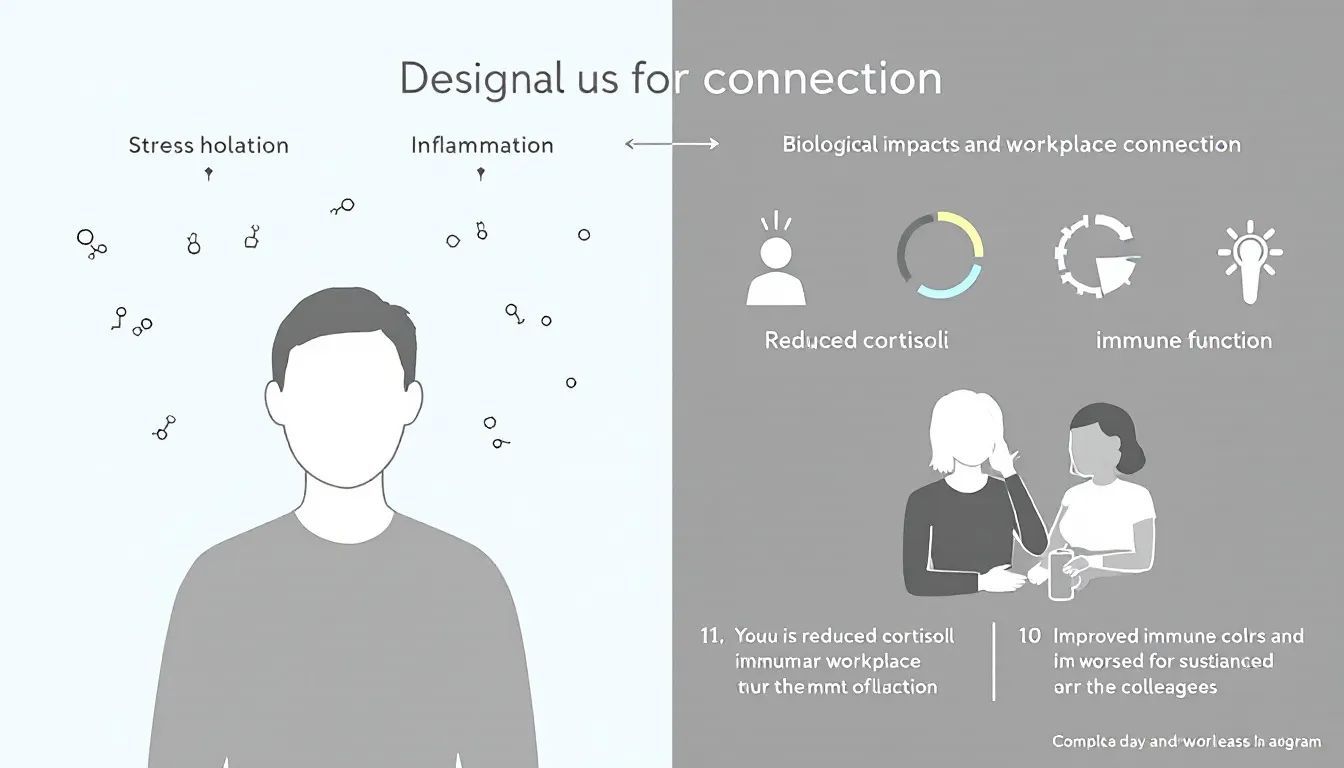In today’s fast-paced, hybrid world, building social connections at work isn’t just a nice-to-have—it’s a core driver of team success and personal well-being. Yet, many organizations still rely on outdated, one-size-fits-all events that rarely spark genuine bonds. What if there were a smarter, more organic way to create lasting workplace relationships—one that uses technology to bring the right people together, at the right time, for authentic connection? Let’s explore why social ties matter more than ever, how to spot when they’re missing, and how innovative solutions like Neroia are rewriting the playbook for workplace belonging.
Why Workplace Relationships Matter More Than Ever
Work is where people spend a third of their lives. For many, it’s the main arena for adult friendships and support. But after years of remote work and rapid change, loneliness and disconnection are rising. According to the U.S. Surgeon General’s 2024 advisory, nearly half of U.S. adults report feeling lonely, with workplace isolation a key factor (CDC, 2025).
The cost is real: disengaged, disconnected employees are less productive, more likely to leave, and more prone to stress and burnout. On the flip side, teams that prioritize building social connections at work see higher engagement, creativity, and resilience. When people feel they belong, they’re not just happier—they’re healthier and more committed, driving better outcomes for everyone.
“The quality of our relationships determines the quality of our lives. In the workplace, social connection is a foundation for well-being, innovation, and growth.”
— U.S. Surgeon General Dr. Vivek Murthy
The Science Behind Social Connection and Employee Health

Biological and Immunological Pathways
Social connection isn’t just a feel-good perk. Research shows it’s a biological necessity. Frequent, positive interactions at work reduce stress hormones like cortisol, boost immune function, and even lower the risk of heart disease (Holt-Lunstad, 2021). Chronic loneliness, by contrast, triggers inflammation and can harm physical health as much as smoking 15 cigarettes a day.
Psychological Upsides: From Stress Buffering to Happiness
Strong workplace bonds act as a buffer against daily stress. Employees with close colleagues report lower anxiety, higher self-esteem, and greater job satisfaction (Stanford CCARE, 2023). They’re more likely to share ideas, support each other through challenges, and bounce back from setbacks. This positive feedback loop fuels both personal happiness and team morale.
The ROI for Organisations
The organizational benefits are just as compelling. According to Gallup and SHRM, teams with high social connection enjoy:
- 21% higher profitability
- 41% lower absenteeism
- 59% less turnover
Investing in building social connections at work isn’t just the right thing to do—it’s a strategic advantage.
Spotting the Warning Signs of Disconnection on Your Team
Rising Absenteeism and Turnover
One red flag is a spike in absences and resignations. Lonely employees miss an average of 5.7 more workdays per year and are much more likely to quit (Cigna, 2020). If your team is seeing more sick days or exits, social isolation could be a hidden factor.
Silent Meetings and Low Idea Sharing
Disconnected teams often have meetings where few speak up, and brainstorming falls flat. When people don’t feel safe or known, they’re less likely to contribute or take creative risks. Watch for long silences, lack of collaboration, or the same voices dominating every discussion.
Mental Health Red Flags Managers Miss
Managers may overlook subtle cues: employees withdrawing from group chats, skipping optional calls, or showing signs of burnout. These can signal deeper issues with belonging and connection. Early intervention is key to preventing long-term harm.
“When people feel invisible at work, their mental health and performance suffer. Recognizing the early signs of disconnection is critical for thriving teams.”
— Anjali Rameshbabu, PhD, NIOSH
Building Social Connections at Work: 6 Proven Strategies
Onboarding Rituals That Spark Immediate Belonging
First impressions matter. Welcoming new hires with small-group introductions, buddy systems, or interest-based meetups helps them feel part of the team from day one. Instead of overwhelming new employees with large, formal events, focus on creating space for real conversations and shared experiences.
Cross-Functional Projects as Friendship Accelerators
Working with colleagues from different departments naturally expands social circles and breaks down silos. Assigning people to cross-functional teams for short-term projects or creative challenges encourages new connections and fresh perspectives.
Digital “Watercoolers” and Chat Norms That Stick
In hybrid and remote settings, informal chat spaces are vital. Dedicated Slack channels for hobbies, interest groups, or casual banter can recreate the spontaneous conversations that used to happen by the coffee machine. Setting simple norms—like encouraging emoji reactions or regular check-ins—keeps these spaces lively and inclusive.
Bullet List: Practical Ways to Build Social Connections at Work
- Host regular micro-events (e.g., yoga, book clubs, running groups)
- Encourage peer shout-outs and recognition in team channels
- Rotate meeting facilitators to give everyone a voice
- Use AI-driven platforms like Neroia to match employees for shared activities
Why Traditional Company Events Fall Short
Large, company-organized events often feel forced or awkward, especially for introverts or remote staff. These gatherings may connect people briefly but rarely lead to lasting relationships. Hybrid teams, in particular, find it hard to bond when in-person attendance is inconsistent and virtual options lack energy.
“Traditional team-building can feel like a checkbox, not a catalyst for real connection. What employees crave are authentic, low-pressure moments to get to know each other.”
— Christine Muldoon, WebMD Health Services
Designing Work to Nurture Belonging in Hybrid and Remote Settings
Crafting Intentional Office Days
For hybrid teams, designating specific in-office days for social activities—not just meetings—can maximize meaningful interactions. Plan shared lunches, walking meetings, or collaborative workshops to help people reconnect beyond their usual tasks.
Running Inclusive Virtual Social Rituals
Remote workers need more than just Zoom calls. Host virtual coffee breaks, online game sessions, or themed chats where participation is easy and optional. Rotate hosts to keep things fresh and ensure everyone, regardless of location, feels welcome.
Planning Events Everyone Can Join
Accessibility and flexibility are key. Offer a mix of in-person, virtual, and hybrid events at different times to include parents, caregivers, and team members in various time zones. Use surveys or AI tools to discover what activities people actually want—then let them opt in.
Bullet List: Hybrid-Friendly Social Activities
- Virtual yoga or meditation sessions
- AI-matched lunch pairings (remote and in-office)
- Rotating micro-groups for cultural or wellness events
- Company-wide challenges (e.g., steps, reading, volunteering)
Leadership’s Role: From Policy to Everyday Behaviors

Modeling Vulnerability and Authenticity
Leaders set the tone. When managers share personal stories, admit challenges, and show genuine interest in others, it signals psychological safety. This openness encourages employees to bring their whole selves to work.
Training Managers in Empathetic Communication
Empathy can be learned. Training supervisors to listen actively, check in regularly, and recognize early signs of isolation empowers them to support team well-being. Small gestures—like remembering birthdays or asking about hobbies—go a long way.
Recognizing and Rewarding Connection-Building Efforts
Celebrate employees who organize social events, welcome newcomers, or support colleagues. Recognition programs that highlight these contributions reinforce a culture of connection. Make it clear that building social connections at work is everyone’s responsibility.
“When leaders champion belonging, it becomes part of the fabric of the organization—not just a line in the handbook.”
— Dr. Joel Axler, National Behavioral Health Leader
Measuring Impact: How to Track and Sustain Stronger Bonds
Fast Pulse Surveys and Network Mapping
Regular, anonymous surveys can reveal how connected employees feel and where gaps exist. Network mapping tools visualize who’s collaborating and who might be isolated, guiding targeted interventions.
Translating Insights into Action Plans
Use survey and network data to design new initiatives—like pairing isolated team members for projects or launching interest-based groups. Share results transparently so employees see their feedback in action.
Iterating Your Culture Playbook
Building social connections at work is an ongoing journey. Review what’s working, gather feedback, and adapt your approach as your team evolves. The most successful organizations treat culture as a living, breathing system.
Ordered List: Steps to Sustain Social Connection Initiatives
- Survey employees quarterly about connection and belonging
- Analyze network data to spot silos and opportunities
- Pilot new micro-events or interest groups based on feedback
- Recognize and reward connection champions
- Adjust and repeat, keeping employee voice at the center
The Future: AI-Driven Micro-Events and the Neroia Revolution
Traditional approaches to building social connections at work often fall short because they’re rigid, generic, or disconnected from real employee interests. That’s where Neroia steps in, revolutionizing workplace culture with AI-driven micro-events designed for authentic, organic bonding.
Neroia’s platform uses artificial intelligence to effortlessly discover and recommend small-group activities—like yoga sessions, company runs, or cultural exchanges—tailored to individual preferences and schedules. Instead of forcing everyone into the same event, Neroia breaks silos by matching 3-4 coworkers for experiences that spark real conversation and friendship. This approach has already shown results in OHB pilot programs, where AI-orchestrated yoga and running groups led to higher engagement and more meaningful connections than traditional gatherings.
What sets Neroia apart is its commitment to privacy, flexibility, and employee-centricity. All recommendations are made using anonymized data, ensuring a secure and trusted community. The platform integrates with existing HR programs and external resources, making it easy to adapt to any organization’s needs. In hybrid and remote settings, Neroia’s curated micro-events help bridge the gap between virtual and in-person teams, ensuring everyone can participate—no matter where they are.
“Neroia’s AI platform is transforming how teams connect. By focusing on small, interest-based groups, we’re seeing authentic relationships bloom—boosting well-being, collaboration, and productivity across the board.”
As workplace expectations evolve, the future belongs to organizations that prioritize building social connections at work through technology that feels human, not forced. With solutions like Neroia leading the way, vibrant, engaged teams are just a click away.
Ready to replace rigid, awkward events with dynamic, AI-tailored interactions? Discover how Neroia can help your organization build the authentic connections that power thriving teams—today and tomorrow.




